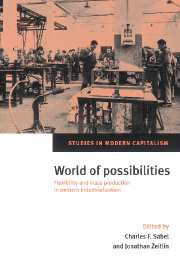Book contents
- Frontmatter
- Contents
- List of contributors
- Acknowledgments
- Stories, strategies, structures: rethinking historical alternatives to mass production
- Part I The modernity of tradition
- Part II The battle of the systems
- 5 Between flexibility and mass production: strategic ambiguity and selective adaptation in the British engineering industry, 1830–1914
- 6 The lost paradigm: an Italian metalworking empire between competing models of production, 1900–1920
- 7 “Have a heart for the manufacturers!”: production, distribution and the decline of American textile manufacturing
- 8 The small-holder economy in Denmark: the exception as variation
- Part III The resurgence of flexible production
- Index
6 - The lost paradigm: an Italian metalworking empire between competing models of production, 1900–1920
Published online by Cambridge University Press: 12 December 2009
- Frontmatter
- Contents
- List of contributors
- Acknowledgments
- Stories, strategies, structures: rethinking historical alternatives to mass production
- Part I The modernity of tradition
- Part II The battle of the systems
- 5 Between flexibility and mass production: strategic ambiguity and selective adaptation in the British engineering industry, 1830–1914
- 6 The lost paradigm: an Italian metalworking empire between competing models of production, 1900–1920
- 7 “Have a heart for the manufacturers!”: production, distribution and the decline of American textile manufacturing
- 8 The small-holder economy in Denmark: the exception as variation
- Part III The resurgence of flexible production
- Index
Summary
At the beginning of the twentieth century a new model emerged for the organization of industrial production, characterized by the manufacture in long series of standardized products, by big firms using specialized tooling and a relatively unskilled labor force. It was a model that tended to oust more flexible forms of organization producing by the unit and based on a skilled workforce. This chapter is concerned with heavy engineering and shipyards in the strategic period before and during the First World War: it aims to study the operation of the different variables governing on the one hand the actual decision to move over from production by the unit or in small quantities to mass production and on the other the execution of that decision; and its focus will be on Ansaldo, a Genoese engineering and shipbuilding company owned by the Perrone Brothers.
Competition between antagonistic forms of organization of production was prevalent not just on the level of sectors or global economies but actually within each company. As two paradigms for the organization of production, mass production and flexible specialization need to be approached not just as explicit systems of representation but also as social strategies and social practices present in a diffused state in the minds of different agents of the business enterprise, either successful or doomed because of the contrasting or even contradictory constraints under which they have to operate. It is my intention to describe the modalities of this competition between flexible production and mass production and to survey the micro-economic factors operative in the social context within which companies operated.
- Type
- Chapter
- Information
- World of PossibilitiesFlexibility and Mass Production in Western Industrialization, pp. 273 - 309Publisher: Cambridge University PressPrint publication year: 1997



